Gum Disease Treatment Albuquerque
Periodontal Therapy for Bleeding Gums
Gum disease (also known as periodontal disease) is the leading cause of tooth loss among American adults – simply put, this health problem is no laughing matter. That’s why Dr. Boehmer's goal is to arrest its development in the earliest stages possible through education, dedicated screenings, and revitalizing gum disease treatment in Albuquerque. If you’re experiencing oral bleeding after flossing or seeing puffy, red oral tissue in the bathroom mirror, contact our Albuquerque dental practice today.
Why Choose Dr. Monica Boehmer for Gum Disease Treatment?
- Completed More Than 2,500 Hours in Continued Education
- Dentist with 20+ Years of Experience
- Dedicated Deep Cleanings for Comprehensive Health Benefits
What is Gum Disease?
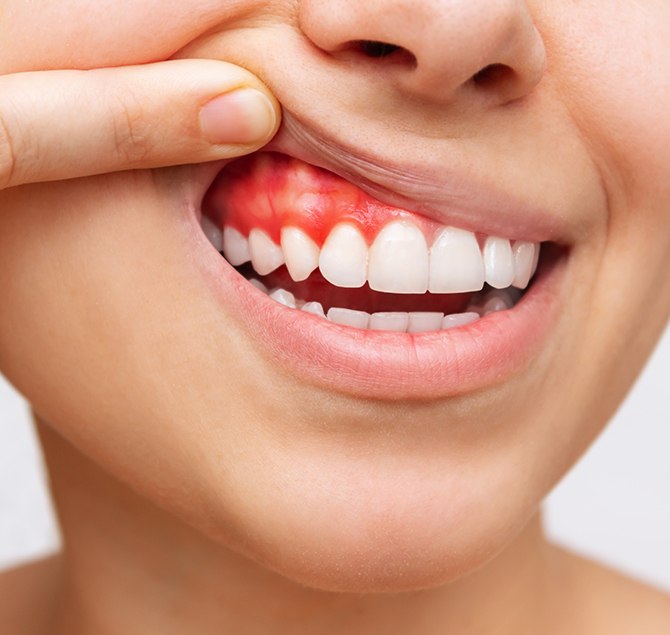
According to the Centers for Disease Control & Prevention (CDC), nearly half of adults aged 30 years and older are living with some form of gum disease. This occurs when a bacterial infection forms inside the mouth and begins to attack the gums and bone. It often develops in different stages with gingivitis – the initial stage – presenting symptoms that can be reversed with regular oral hygiene habits and professional cleanings. If left untreated, it can advance and become periodontitis, which can only be managed, not cured.
Symptoms of Gum Disease

The symptoms of gum disease will vary from person to person; however, if you notice any of the following, do not hesitate to call and schedule an appointment with Dr. Boehmer:
- Bleeding or inflamed gums
- Red and tender gums
- Bad breath or halitosis
- Gum recession (your teeth appear longer than before)
- Difficulty or pain while chewing
- Tooth sensitivity
- Loose permanent teeth
- Change in your bite or how your restorations fit
- Permanent tooth loss
How Do We Treat Gum Disease?

Treating gum disease begins by meeting with Dr. Boehmer to discuss the various options that are available. After examining your mouth and determining the severity of your condition, she will go over which method of care will be best for your oral and overall health.
Laser Gum Disease Treatment
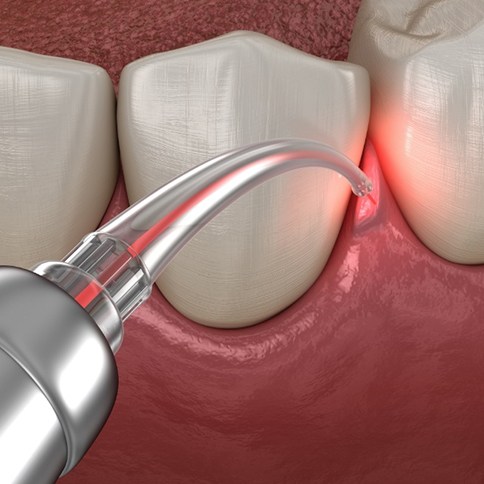
Laser dentistry is an effective way to treat gum disease because of its ability to target diseased tissues while leaving healthy areas untouched. By cleaning the gum pockets of bad bacteria and infection, healthier tissue can begin to regenerate and reattach to the bone. Laser gum disease treatment is less invasive and allows for faster healing, in part because it reduces bleeding and swelling, and minimizes the risk of post-operative infection.
Antibiotic Treatment

Antibiotic treatment with ARESTIN is often combined with scaling and root planing to further curb and control periodontal infection. This medication comes in the form of a powder that’s directly applied to the gum pockets. There, it adheres to the inflamed tissue and releases a steady flow of potent antibiotics that continues to fight leftover bacteria for weeks following your initial treatment.
Scaling and Root Planing
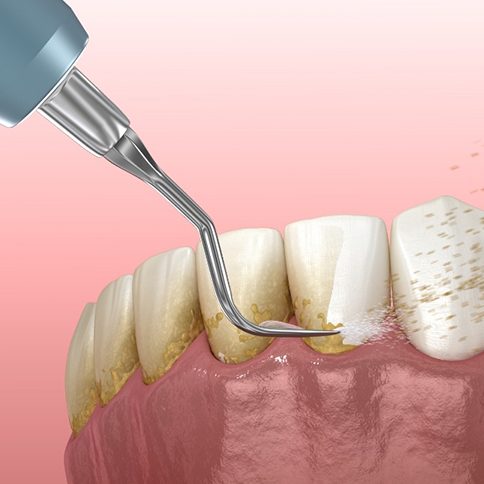
Scaling and root planing is an in-depth professional cleaning that targets plaque and tartar buildup throughout the mouth to promote better gum health. When an infection forms as a result of bacterial accumulation, inflammation, bleeding, and tenderness can occur. If left untreated, gum pockets can form, making it easier for the bacteria to spread from the gumline and teeth to the underlying bone and bloodstream, impacting various areas of the body. With scaling and root planing, though, Dr. Boehmer can quickly address the problem to prevent additional damage to a person’s oral and overall health.
Do You Need Scaling & Root Planing?

When gum disease is in its earliest stages – gingivitis – symptoms can be reversed with regular cleanings and good at-home oral hygiene. However, if bacteria are allowed to spread further into the soft oral tissues, the infection can lead to significant problems that indicate the need for scaling and root planing, such as:
- Bleeding or swollen gum tissue
- Bad breath or halitosis
- Receding gumline
- Teeth feel loose or are shifting
- Unpleasant taste in your mouth
- Difficulty chewing
Without addressing the issue in a timely manner, the risk of the infection reaching the bloodstream and traveling to other areas of the body drastically increases. Gum disease is commonly linked to cardiovascular disease, cognitive decline (i.e., dementia, Alzheimer's), tooth loss, heart attack, and diabetes complications.
The Process of Scaling & Root Planing

Scaling and root planing is performed in two distinct sections – first, the “scaling” portion will cleanse above and below the gumline, reaching down to the tooth’s roots. Then, during the “root planing” procedure, the tooth root surfaces will be gradually smoothed of any rough areas, which are prime targets for bacterial accumulation.
Our goal is to encourage the inflamed gum tissue to become firm once more, causing the periodontal pockets to shrink so that they can reattach to the teeth.
Aftercare Tips for Scaling & Root Planing

When our team is finished with scaling and root planing, there will likely be some mild soreness for a few days. This is normal, but be mindful of any sensitivity you might feel afterward, as well as bleeding or swelling. As your gum tissues begin to heal, you will need to be proactive about your oral hygiene routine and avoid bad bacterial growth. You can do this by staying on top of your brushing and flossing habits as well as using an antibiotic or prescription-based mouthwash.
If you experience discomfort, don’t hesitate to take an over-the-counter pain reliever, as this should only be temporary. Within 1-2 weeks, you should no longer feel any tenderness or sensitivity.
Laser Periodontal Treatment
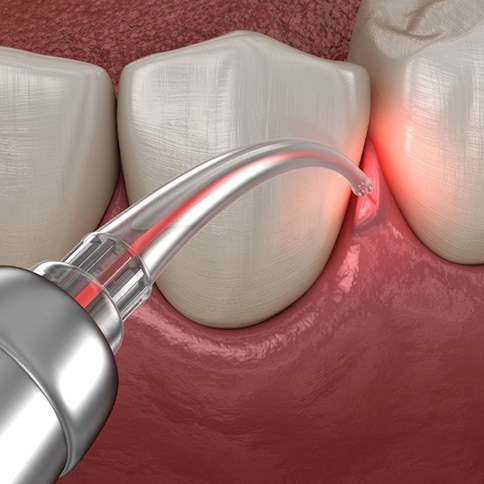
Laser dentistry is an effective way to treat gum disease because of its ability to target diseased tissues while leaving healthy areas untouched. By cleaning the gum pockets of bad bacteria and infection, healthier tissue can begin to regenerate and reattach to the bone. Laser gum disease treatment is less invasive and allows for faster healing, in part because it reduces bleeding and swelling, and minimizes the risk of post-operative infection.
How Laser Periodontal Treatment Works
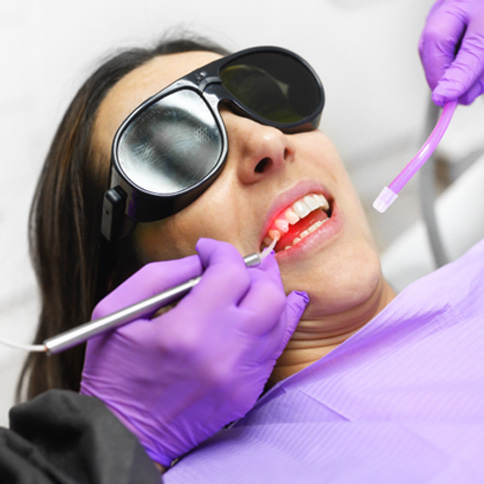
If Dr. Boehmer recommends this type of treatment, do not expect it to be a standalone procedure. It’s often performed alongside scaling and root planing and is most often used to reduce inflammation and prevent the spread of infection.
By using the dental laser to minimize bacteria, she can also remove damaged tissues, creating a much less invasive process. The laser will only target bad bacteria, leaving all healthy tissue untouched so that it can properly reattach to your teeth.
Once this part of the process is finished, she will move on to scaling and root planing, effectively removing tartar and plaque from your teeth and gumline, as well as the roots.
The Benefits of Laser Periodontal Treatment

The inclusion of a dental laser to treat gum disease offers many great benefits that patients can expect, such as:
- A less invasive procedure because of how easy it is to perform, unlike using a scalpel
- How effective the laser is at eliminating bacteria on contact
- There is no need for sutures
- There is a reduced risk of future infections with laser gum disease treatment, according to various studies
- A person will remain more comfortable throughout treatment
- Healthier gum tissue remaining intact
- The laser also cauterizes the tissues during the process, so the chances of post-operative infection remain low
- Reduced bleeding and swelling during and after the procedure because of how the dental laser is used
Aftercare Tips for Laser Periodontal Treatment
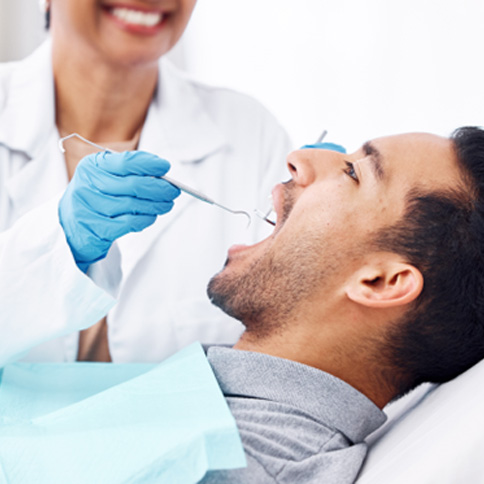
When recovering from laser periodontal treatment, you can expect to recover quickly. It usually only takes about one week to fully heal, which is significantly faster than traditional non-laser gum surgeries, which can take 2-4 weeks.
You may experience some slight swelling or sensitivity after the procedure, but taking an over-the-counter pain reliever can ease the discomfort. Also, you’ll need to avoid certain foods (i.e., anything hot, cold, spicy, or acidic) to prevent increased sensitivity.
Finally, you should expect to meet with Dr. Boehmer for a follow-up visit, but if you begin to notice your pain worsening at any time, do not hesitate to reach out right away.
